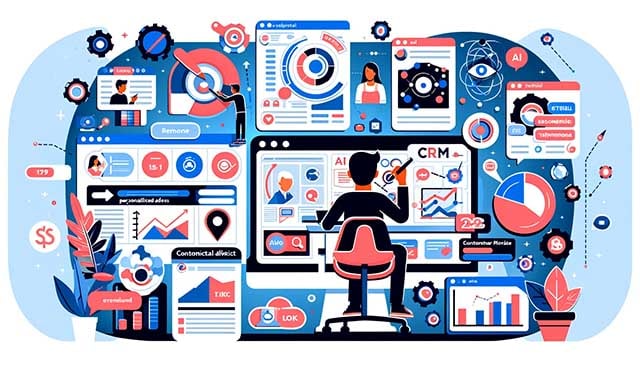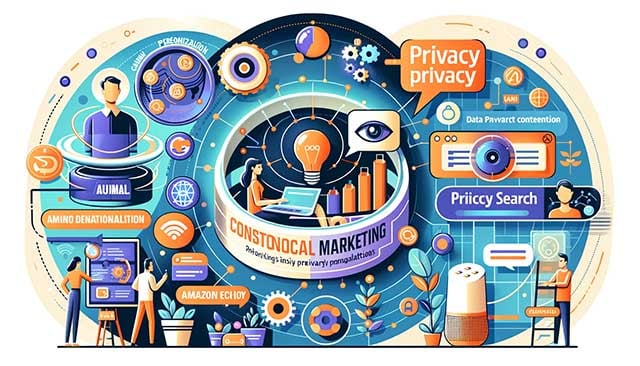Planning a Contextual Marketing Strategy: A Success Guide
- Home
- Planning a Contextual Marketing Strategy: A Success Guide
Planning a Contextual Marketing Strategy can seem like navigating through uncharted waters.
Navigating the ever-changing digital marketing landscape can be daunting, but a well-crafted contextual marketing strategy can help guide you through.
But here's the thing...
A well-crafted contextual marketing strategy can be your compass in this sea of information. It helps you understand your customers better, deliver personalized experiences, and ultimately drive conversions.
This isn't just about throwing some ads out there hoping they'll stick. No sir!
Your strategy should be based on facts and tailored to the customer. That's where contextual marketing comes into play.
If done right, it has the potential to transform how you engage with your audience online - leading them on a journey that feels personal and relevant every step of the way.
Table of Contents:
- Decoding the Intricacies of Contextual Marketing
- Delineating Effective Buyer Personas
- Building Effective Buyer Personas
- Implementing Contextual Marketing Strategies
- Enhancing Conversion Rates with Contextual Marketing
- Contextual Marketing Tools & Technologies: The Key to Personalization
- Navigating Success Metrics In Contextual Marketing
- Measuring the Success of Contextual Marketing
- Future Trends in Contextual Marketing
- FAQs about Planning a Contextual Marketing Strategy
- Conclusion

Decoding the Intricacies of Contextual Marketing
In the rapidly changing landscape of digital marketing, one term that frequently pops up is contextual marketing. This innovative approach seeks to enhance user experience by personalizing it according to individual identities and preferences.
The Influence of Contextual Marketing in Crafting Personalized User Experiences
At its core, contextual marketing capitalizes on data related to a customer's behaviour, interests, and needs. It utilizes this information to customize their online interactions with your brand - be it through personalized product recommendations or targeted email campaigns.
This strategic approach not only enriches the overall customer experience but also bolsters engagement rates by making customers feel understood and valued. By delivering relevant content at opportune moments, businesses can cultivate stronger relationships with their customers while simultaneously driving conversions.
To illustrate this concept better, consider a visitor who has been browsing winter coats on your website for some time without finalizing a purchase. An effective strategy would be sending them an email showcasing popular winter coat options or offering special discounts tailored just for them. Such strategies have proven successful in increasing conversion rates as they cater directly to individual consumer needs.
Delineating Effective Buyer Personas
If you wish to harness the full potential of contextual marketing, understanding your audience becomes paramount - enter buyer personas. These detailed representations offer insights into different segments within your target market and play an instrumental role in shaping any triumphant digital marketing strategy.
Building Effective Buyer Personas
The key to unlocking the potential of your contextual marketing strategy is knowing who you're talking to. That's where buyer personas come in.
A buyer persona, a semi-fictional representation of your ideal customer, can be an invaluable tool for understanding customer behaviour patterns and tailoring your messaging accordingly.
Creating Detailed Buyer Personas with HubSpot
To create detailed buyer personas that will guide your marketing efforts effectively, turn to HubSpot's smart content features. These tools enable segmentation based on various parameters such as specific website activities or lifecycle stages.
This level of segmentation allows you to deliver personalized experiences that resonate with each unique persona while also facilitating efficient data collection about user interactions across different channels.
- Data Collection: Gather demographic information like age, location, job title, etc., along with psychographic details such as interests and preferences through forms on landing pages or surveys sent via email campaigns.
- Data Analysis: Use this collected data to identify common trends among groups within your target audience. This will help define distinct segments that share similar characteristics or behaviours - forming the basis of individual buyer personas.
- User Experience Mapping: Map out the user journey for each persona from their first interaction with your brand until conversion (and beyond). This helps them understand what motivates them at every step and informs them how best to engage them throughout their journey.
Beyond creating these personas initially is maintaining them over time using new insights gained from ongoing customer interactions. Remember: Smart content in HubSpot offers various options for segmentation; it's all about utilizing those capabilities effectively.
Nurturing Relationships Through Contextual Marketing
Incorporating these detailed buyer personas into a contextual marketing approach ensures that messaging aligns perfectly with the needs and wants of each segment. By delivering relevant content at precisely the right time in their buying cycle - whether they're only beginning their search or ready to make a purchase - businesses can nurture relationships more efficiently while enhancing overall customer experience. This method isn't limited solely to inbound tactics either; it applies equally well across outbound efforts too. The key
Master your contextual marketing strategy by understanding and speaking directly to your audience. Craft detailed buyer personas with tools like HubSpot, gather and analyze customer data, then tailor experiences for each persona's journey. Remember: the right message at the right time nurtures relationships and boosts conversions.

Implementing Contextual Marketing Strategies
The journey to develop a contextual marketing strategy may seem challenging, but the process is quite manageable when broken down into stages. The key lies in understanding your customer data and using it for personalized marketing.
1. Gathering Customer Data
To begin with, how do you gain insights about your customers? How can you understand their preferences and habits?
Your first step should be collecting comprehensive customer data from various sources such as social media interactions, website analytics, or feedback surveys. Gathering customer data can provide a foundation for personalization, and tools such as Google Analytics help understand user behaviour.
This isn't overly complicated - start small by focusing on one aspect of your business where personalization could make an impact and gradually expand based on results. Marketing automation tools, for instance, are useful in gathering real-time insight.
2. Analyzing Collected Data
Analyzing this collected data is the next crucial stage that helps identify patterns among different segments of customers. It's not just about having the information; it's also about interpreting what these behaviours mean to create highly targeted advertising strategies based on individualized customer profiles.
You're capable of doing this. By predicting future behaviour based on past actions, businesses can craft personalized messages that resonate directly with each consumer's unique needs and desires, aligning seamlessly with overall company goals.
Prioritize high-traffic pages during campaign execution since they offer greater opportunities to reach wider audiences more effectively according to key statistics available from industry experts, reports, studies, research papers, and other reliable sources online and offline alike. Choosing the correct platform is essential to reaching desired outcomes such as higher conversion rates, increased revenue, and expanding market share.
In addition, continuous testing and adjustment are required to maintain effectiveness over time as changes occur within target demographics, technological advancements, innovations, emerging markets, and shifts in consumer attitudes and behaviours towards certain products, services, brands, industries, regions, countries, cultures, societies, economies, environments, politics, religions
Mastering contextual marketing isn't rocket science. Start by gathering customer data, then analyze to spot patterns and predict behaviours. Prioritize high-traffic pages for campaigns, choose the right platform wisely, and remember - adjust continually for changing trends.

Enhancing Conversion Rates with Contextual Marketing
Contextual marketing is a powerful strategy that can significantly improve conversion rates. By leveraging customer data and preferences, it delivers targeted advertising that creates personalized experiences for your audience.
The Secret Sauce: Personalization in Contextual Advertising
In the world of digital marketing, attracting high volumes of traffic isn't enough to secure high conversion rates. The secret lies in understanding what makes your visitors tick - their interests, behaviours, needs, and wants. High-traffic pages are the perfect playgrounds for implementing contextual marketing efforts as they provide ample opportunities to gather user-specific data.
This treasure trove of information allows you to create ads so relevant they feel tailor-made for each user. When customers see content directly aligned with their preferences or current situation, engagement skyrockets - leading to not only increased click-through rates but also higher conversions.
Data-Driven Targeting: Your Key To Success
To implement successful contextual marketing strategies, businesses need accurate methods of collecting customer data like tracking website interactions or analyzing social media behavior. Once the data has been collected, it is time to analyze it to discern patterns among your target audience that will inform the creation of tailored messages designed for maximum engagement and conversion.
Analyzing these insights will help understand patterns among your target audience, which then informs the creation of personalized messages designed specifically around these findings - thus improving engagement levels and boosting conversion rates as a result.
Leveraging Technology For Improved Results
We live in an era where technology evolves at lightning speed, offering numerous tools that streamline the process of collecting customer data for contextual advertising purposes while optimizing ad performance based on real-time feedback.
Such technologies enable marketers not just to collect vast amounts of consumer behaviour data but also to analyze them efficiently, making sense of different types of smart content and enhancing personalization even further.
The result? A significantly improved ability to drive up conversions through precisely targeted campaigns crafted using richly detailed consumer profiles built over time by continually refining targeting parameters based on ongoing user interaction analysis.
Contextual marketing is the key to unlocking high conversion rates. By harnessing customer data, understanding user behaviour and leveraging technology, you can create personalized ads that resonate with your audience and boost engagement levels.

Contextual Marketing Tools & Technologies: The Key to Personalization
The world of contextual marketing is vast and full of various tools, particularly CRM tools for contextual advertising. These are the engines that drive advanced behavioural targeting techniques, allowing businesses to deliver personalized content based on a user's context.
CRM Tools: Powering Contextual Advertising
A Customer Relationship Management (CRM) tool isn't just an asset; it's essential in any contextual marketing strategy. This software collects and analyzes customer data, enabling marketers to understand their audience better and craft more targeted messages.
Pioneers like HubSpot or Zoho have designed features specifically tailored for contextual advertising within their CRM platforms. They allow segmentation of customers based on behaviour, preferences, past interactions - you name it.
This segmentation leads us down the path towards smart content types enhancing personalization. Users respond positively when they receive relevant content that resonates with them - leading to improved engagement rates.
Behavioural Targeting Techniques: A Deeper Dive into User Behavior
Moving beyond CRM tools, there exist several other technologies employed in implementing behavioural targeting techniques in contextual advertising. Cookies-based tracking systems monitor online behaviours such as browsing history or click patterns, while AI-powered predictive analytics software anticipates future actions based on past behaviour.
Add real-time bidding systems into this mix, which enable advertisers to bid for ad space depending upon the relevance and value perceived by a specific visitor profile - we're talking about truly personalized interaction opportunities here. Google Ads' remarketing feature and Facebook's custom audiences option exemplify these techniques implemented at scale, adding another layer onto your CRM system allowing not only understanding who your customers are but also predicting what they might do next, providing an opportunity for truly personalized interaction.
Navigating Success Metrics In Contextual Marketing
To ensure success in crafting a robust Contextual Marketing Strategy, one mustn't forget about measuring outcomes.
As we move forward into our next section, let's focus on key metrics required for tracking success along with methodologies suitable for sales figures interpretation, ensuring optimal ROI from these campaigns.
Key Takeaway: Contextual marketing thrives on personalization, powered by CRM tools and behavioral targeting techniques. These technologies analyze customer data for tailored content delivery, enhancing engagement rates. Remember to track success metrics for optimal ROI from your campaigns.
![]()
Measuring the Success of Contextual Marketing
Contextual marketing's success hinges on the careful tracking and analysis of key metrics. This includes engagement rates, conversion rates, customer retention rates, and more.
The potential to maximize your ROI with contextual marketing is immense in today's digital age. While it may seem that AI could overshadow this strategy, it can bolster your campaign effectiveness significantly.
For instance, a well-executed marketing analytics approach, akin to how Express Writers optimized their content services (including SEO blog writing for small businesses), can drive up these key metrics - a clear sign of successful contextual marketing.
Determining Key Metrics for Tracking Success
In the world of personalized context-driven campaigns, certain performance indicators shine brighter than others. Click-through rate (CTR) is one such metric that measures the ratio between users who clicked on your content versus those who merely saw it. A high CTR suggests that you've hit the mark with audience relevance.
Bounce rate also plays an essential role as it reflects visitors' engagement level by showing what percentage leave after viewing just one page on your site. Lower bounce rates point towards engaging and relevant content successfully retaining visitor attention.
A third critical indicator is conversion rate - showcasing how many website visitors perform desired actions like purchases or newsletter sign-ups. Rising conversion rates indicate effective targeting coupled with compelling calls-to-action within your tailored messaging.
Evaluating Sales Figures & ROI
Sales figures offer direct insights into whether customers are responding positively to personalized context-driven campaigns; higher sales numbers suggest successful consumer demand fulfilment through customized communication.
Return on Investment (ROI), meanwhile, gives an overall snapshot of profitability from these efforts: comparing total revenue against campaign costs provides valuable financial efficiency data points.
Positive ROI indicates earning more than spent in executing the campaign - another undeniable marker of success.
Key Takeaway: Contextual marketing success is a numbers game. Monitor engagement, conversion and retention rates to gauge effectiveness. Use AI to boost campaigns, and aim for high click-throughs and low bounce rates. Remember, higher sales and positive ROI spell triumph.

Future Trends in Contextual Marketing
The landscape of contextual marketing is ever-evolving, shaped by emerging technologies and innovative strategies. Here are the key trends that will play a significant role in shaping this field.
1. Harnessing AI for Personalization
The use of Artificial Intelligence (AI) has revolutionized personalized context-driven campaigns. It's now possible to analyze consumer behaviour and search patterns on an unprecedented scale, allowing businesses to gain deep insights into how users discover their products or services.
However, it's crucial to exercise caution when using personalization at such an extensive level - with advanced algorithms able to tailor content based on individual preferences, this trend is set only to grow stronger in the future.
2. Balancing Data Privacy Regulations with Personalized Marketing
Data privacy regulations worldwide are becoming increasingly stringent. Marketers must strike a balance between delivering personalized experiences while respecting user privacy rights - "It's about ensuring you can justify which personal data you need and why."
This situation will likely push marketers towards consent-based marketing practices where transparency becomes paramount—a substantial shift away from intrusive advertising methods seen previously.
3. Adapting SEO Strategies for Voice Search Optimization
Voice search optimization is another rising trend significantly impacting SEO strategies due to its increasing usage among consumers via devices like Amazon Echo or Google Home. "50% of all searches will be voice searches by 2023." This development necessitates adapting keyword planning around conversational queries rather than traditional short-tail keywords.
Evolving Role Of Chatbots In Customer Experience
In today's fast-paced world, 'waiting' has become unacceptable for customers seeking immediate responses. Chatbots powered by Natural Language Processing (NLP) offer real-time engagement, a huge advantage over human operators limited by time constraints. This technology allows brands not just to reactively respond but proactively engage customers - a major paradigm shift.
Contextual marketing is in flux, with AI personalization, data privacy regulations, voice search optimization and chatbots shaping its future. Balancing personalized experiences with user privacy rights is key while adapting SEO strategies for conversational queries becomes crucial. Chatbots are transforming customer engagement from reactive to proactive.
FAQs about Planning a Contextual Marketing Strategy
What are contextual marketing strategies?
Contextual marketing strategies involve tailoring advertising content based on user data and preferences to enhance customer experience and boost conversions.
What is an example of a contextual marketing plan?
An example could be using CRM tools like HubSpot to create buyer personas, collect customer data, implement personalized campaigns, and track success through key metrics.
What is contextual marketing?
Contextual marketing is a form of targeted advertising where the ads align with the context or content that the user is viewing. It enhances personalization and relevance in digital experiences.
What is an example of a contextual advertising strategy?
A common example would be displaying fitness equipment ads on health blogs. The ad matches the blog's theme, thus increasing its relevancy to readers who may have an interest in such products.
Conclusion
Understanding contextual marketing is the first step in planning a successful strategy.
Building effective buyer personas can streamline your approach and enhance customer experience.
The power of CRM tools for implementing advanced behavioural targeting techniques cannot be overstated.
A careful analysis of key metrics, sales figures, and ROI will help you measure the success of your campaigns.
Trends are constantly evolving; staying updated with emerging technologies can shape the future of personalized context-driven campaigns.
Let us assist you in developing a contextual marketing strategy that your target audience will be drawn to, and watch as it revolutionizes the way you do business. Learn how we can transform your digital presence by creating an effective contextual marketing strategy that resonates with your audience here. Let us help you reach new heights - it'll change how you do business forever!


